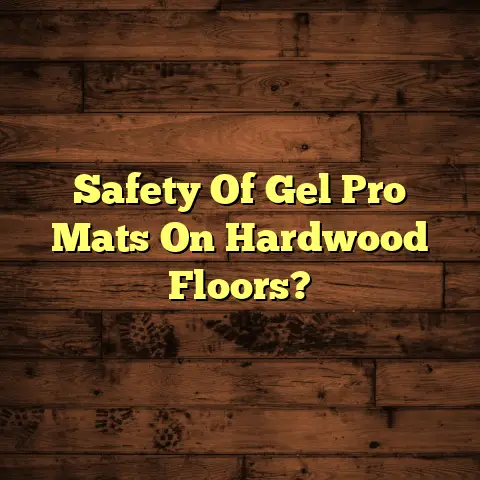Replace Subfloor? Know This First! (1 Sign)
But one thing I’ve learned is that what’s underneath your beautiful hardwood or plush carpet is just as important, if not more so, than what you see.
I’m talking about your subfloor.
Now, if you’re a parent like me, you know that a safe and healthy home is everything. We want our kids to have a space where they can thrive, play, and grow without us constantly worrying about hidden dangers.
And believe me, a damaged subfloor can be a hidden danger.
Think about it: your kids are crawling, running, jumping, and exploring every nook and cranny of your home.
A weak or damaged subfloor can lead to accidents, health problems, and a whole lot of stress for you.
That’s why I’m writing this article.
I want to shed some light on this often-overlooked part of your home and give you the knowledge you need to protect your family.
We’ll dive into what a subfloor is, why it’s so important, and, most importantly, the one key sign that tells you it might be time for a replacement.
So, let’s get started and make sure your home is a safe haven for your little ones!
Section 1: Understanding Subfloors
Okay, let’s break down what a subfloor actually is. Simply put, it’s the foundation upon which your finished flooring rests.
Think of it as the unsung hero of your home’s flooring system. It provides a stable, level, and solid surface for your carpet, tile, hardwood, or laminate to be installed on.
Without a proper subfloor, your flooring could be uneven, bouncy, or even prone to damage.
Now, what are these subfloors made of?
The most common materials you’ll find are:
-
Plywood: This is a popular choice because it’s relatively inexpensive, strong, and easy to work with. It’s made of layers of wood veneer glued together.
-
Oriented Strand Board (OSB): OSB is similar to plywood but is made from wood strands compressed and glued together. It’s generally more affordable than plywood, but can be more susceptible to moisture damage.
-
Concrete: In some homes, especially those with slab foundations, the subfloor is simply a concrete slab. This is a very durable option, but it can be cold and hard underfoot.
So, how does the subfloor interact with your main flooring?
Well, it acts as a bridge, distributing weight and impact evenly across the floor. It also helps to insulate your home and reduce noise transmission.
A sound subfloor is crucial, especially when you have kids. Think about all the wear and tear they put on your floors!
A good subfloor will withstand their energy and help prevent accidents.
According to the American Academy of Pediatrics, falls are a leading cause of injury for children.
A solid, even subfloor can help reduce the risk of trips and falls.
Section 2: Signs of Subfloor Damage
Now, let’s get to the heart of the matter: how do you know if your subfloor is in trouble?
There are several signs to look out for, but I want to focus on the one critical sign that should raise a big red flag:
Soft or Spongy Spots
Have you ever walked across a certain area of your floor and felt like you were sinking slightly?
Or maybe it feels like there’s a little “give” under your feet?
That’s what I mean by soft or spongy spots, and it’s a major indicator of subfloor problems.
These spots develop for a few key reasons:
-
Water Damage: This is the most common culprit. Leaks from plumbing, spills that aren’t cleaned up promptly, or even high humidity can seep into the subfloor and cause it to rot and weaken.
-
Excessive Weight: If you have heavy furniture or appliances concentrated in one area, it can put too much stress on the subfloor and cause it to sag.
-
Age: Over time, even the best subfloors can deteriorate simply due to age and wear and tear.
Why are these soft spots so concerning, especially with kids around?
Well, for starters, they’re a tripping hazard. Imagine your child running through the house and suddenly stepping on a weak spot that gives way. Ouch!
But it’s not just about trips and falls. Soft spots often indicate that the subfloor is rotting or moldy.
Mold can release spores into the air, which can trigger allergies and asthma in sensitive individuals, especially children.
According to the EPA, children are more susceptible to mold’s effects due to their developing immune systems.
I remember one family I worked with a few years ago. They had noticed a soft spot in their hallway, but they didn’t think much of it.
They had a toddler who loved to play in that area.
One day, the little girl stepped on the soft spot, and the subfloor actually broke through!
Thankfully, she wasn’t seriously injured, but it was a wake-up call for the parents.
When I inspected the subfloor, I found extensive water damage and mold growth.
We had to replace a large section of the subfloor to ensure the safety of their home.
Here are a few questions to ask yourself:
- Do you notice any areas of your floor that feel softer or more flexible than others?
- Have you had any recent leaks or spills in your home?
- Do you have any concerns about mold or mildew?
If you answered “yes” to any of these questions, it’s time to investigate further.
Section 3: The Impact of Subfloor Problems on Families
Okay, so we know what soft spots are and why they’re a bad sign.
But let’s really dig into how subfloor damage can impact your family’s health and well-being.
It’s not just about the structural integrity of your home; it’s about creating a safe and healthy environment for your loved ones.
One of the biggest concerns is the increase in allergens and health risks.
As I mentioned earlier, water damage can lead to mold and mildew growth.
These nasty organisms release spores into the air, which can trigger a range of health problems, including:
- Allergies: Sneezing, coughing, itchy eyes, and runny nose.
- Asthma: Wheezing, shortness of breath, and chest tightness.
- Respiratory Infections: Bronchitis and pneumonia.
Children are particularly vulnerable to these effects because their immune systems are still developing.
According to the CDC, children with asthma are more likely to experience asthma attacks when exposed to mold.
Subfloor damage can also lead to noise issues.
A weak or damaged subfloor can amplify sounds, making your home feel less peaceful and more chaotic.
This can be especially disruptive for children who need a quiet environment to sleep, study, or simply relax.
Imagine trying to put your baby down for a nap when every footstep on the creaky floor above is amplified.
It’s enough to drive any parent crazy!
But beyond the physical health risks and noise issues, there’s also a psychological aspect to consider.
Living in a home with flooring concerns can be stressful, especially for parents who are constantly worried about their children’s safety.
That nagging feeling that something is wrong can take a toll on your mental health and create a sense of unease in your home.
Dr. Emily Carter, a child psychologist, explains, “A parent’s anxiety about the safety of their home environment can directly impact a child’s sense of security and well-being.
Children are very perceptive and can pick up on their parents’ stress, which can lead to increased anxiety and behavioral issues.”
I’ve seen this firsthand with many of my clients.
Parents who are constantly worried about their children tripping or falling on a damaged floor are often more stressed and less able to enjoy their time at home.
That’s why it’s so important to address subfloor problems promptly.
Not only will it protect your family’s physical health, but it will also create a more peaceful and secure environment for everyone.
Section 4: Addressing the Issue
Okay, you’ve identified a soft spot in your floor. Now what?
Don’t panic! Here’s a step-by-step guide to addressing the issue and getting your home back on solid ground.
Step 1: Consult a Professional
The first and most important step is to call a qualified flooring contractor or home inspector.
They can assess the extent of the damage and determine the best course of action.
Don’t try to DIY this! Subfloor problems can be complex, and you could end up making the situation worse if you don’t know what you’re doing.
A professional will have the tools and expertise to properly diagnose the problem and recommend the right solution.
Step 2: Determine Repair vs. Replacement
Depending on the severity of the damage, you may be able to repair the subfloor instead of replacing it entirely.
If the damage is localized to a small area, a repair may be sufficient.
This typically involves removing the damaged section of the subfloor and replacing it with new material.
However, if the damage is extensive or if there’s evidence of mold or rot, a full replacement may be necessary.
This involves removing the entire subfloor and installing a new one.
Step 3: Prepare for the Project
Whether you’re repairing or replacing your subfloor, it’s important to prepare for the project, especially if you have children in the home.
Here are a few tips:
-
Organize Play Areas: If possible, set up a temporary play area in a room that’s not being worked on. This will help keep your kids out of the construction zone and minimize disruptions.
-
Set Up Temporary Living Spaces: If the project is going to take several days, consider setting up a temporary living space in another part of your home. This could involve moving furniture and appliances to create a comfortable area where you can relax and eat meals.
-
Communicate with Your Contractor: Keep in close communication with your contractor throughout the project. Ask questions, voice your concerns, and make sure you understand the timeline and the scope of the work.
Step 4: Consider the Impact on Family Life
Subfloor repairs or replacements can be disruptive, but it’s important to remember that it’s a temporary inconvenience.
Focus on the long-term benefits of having a safe and healthy home for your family.
Talk to your children about the project and explain why it’s important.
Involve them in the process by letting them help with small tasks, such as cleaning up or organizing their toys.
According to a study by the National Association of Home Builders, the average cost of replacing a subfloor is between $500 and $2,000, depending on the size of the area and the materials used.
While this may seem like a significant investment, it’s important to consider the long-term benefits of having a safe and healthy home.
Section 5: Preventive Measures and Maintenance Tips
Okay, you’ve addressed your subfloor problem. Now, how do you prevent it from happening again?
Here are some preventive measures and maintenance tips to keep your subfloors in tip-top shape, especially when you have kids:
Regular Inspections
Make it a habit to inspect your floors regularly, paying close attention to areas that are prone to moisture or heavy traffic.
Look for soft spots, cracks, or any other signs of damage.
Don’t just rely on your eyes; use your hands to feel for any unevenness or sponginess.
Moisture Control
Moisture is the enemy of subfloors. Take steps to control moisture in your home, especially in areas like kitchens, bathrooms, and laundry rooms.
- Clean up spills immediately.
- Use exhaust fans in bathrooms and kitchens to vent moisture outside.
- Ensure proper ventilation in crawl spaces and basements.
- Consider using a dehumidifier in damp areas.
Educate Your Children
Teach your children to be careful with heavy items and spills. Explain to them why it’s important to protect the floors.
Encourage them to clean up their own messes and to avoid dragging heavy objects across the floor.
Proper Flooring Installation
When installing new flooring, make sure it’s done properly.
This includes using the right underlayment and ensuring that the flooring is properly sealed.
A poorly installed floor can trap moisture and lead to subfloor damage.
Regular Maintenance
Regularly clean and maintain your floors according to the manufacturer’s instructions.
This will help prevent dirt and grime from accumulating and damaging the subfloor.
Avoid using harsh chemicals or abrasive cleaners, as these can damage the flooring and the subfloor.
According to the National Wood Flooring Association, proper maintenance can extend the life of your wood floors by up to 50%.
This not only saves you money in the long run but also helps protect your subfloor.
By following these preventive measures and maintenance tips, you can keep your subfloors in good condition and protect your family from the risks associated with subfloor damage.
Conclusion
So, there you have it! We’ve covered everything you need to know about subfloors, from what they are to how to prevent damage.
I hope this article has empowered you with the knowledge you need to protect your family and create a safe and healthy home.
Remember, being vigilant about subfloor conditions is especially important for the safety of children.
They’re more susceptible to the health risks associated with mold and allergens, and they’re also more likely to trip and fall on damaged floors.
By being proactive and addressing subfloor problems promptly, you can prevent larger issues down the road and ensure a safe and secure environment for your kids to grow and play.
Don’t wait until it’s too late. Take the first step in assessing your home’s flooring today.
Check for soft spots, look for signs of moisture damage, and consult with a professional if you have any concerns.
Remember, awareness is the first step towards a safe home.
As a parent, I know that your children’s safety is your top priority. By taking care of your subfloors, you’re taking care of your family.





